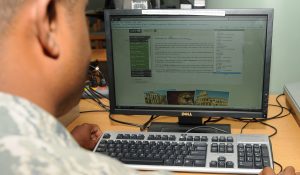While we look forward to the return of students and faculty to campus, it’s quite evident that this upcoming academic year will look very different from any in the past. The last two weeks of the Fall 2020 semester will be taught remotely, and final exams will be take-home or online. In addition, many classrooms on campus will be upgraded to support hybrid learning environments.
With this in mind, many of our faculty are working hard to move course content online, as well as refine courses that were moved online on short notice this past spring. University Libraries has compiled some resources to support faculty in these efforts.
LinkedIn Learning Courses

Members of the CUA community have access to LinkedIn Learning, an online video training library with thousands of courses and videos on a range of topics. Here are some relevant courses and sections:
Learning to Teach Online
- Beginner Skill Level, 46 minutes
- This course is designed to help instructors update their skill sets to teach effectively online. The course instructor shows the links between high-quality instruction and online education. He provides a framework for creating a digital classroom and guidance to get students interacting with the course material, the instructor, and each other.
- Link to course: https://www.linkedin.com/learning/learning-to-teach-online/
Moving Your Class Online Quickly and Efficiently
- General Skill Level, 1 hour 7 minutes
- As the name suggests, this course breaks down how to move a course designed for face-to-face instruction online. The instructors provide strategies for breaking down your existing syllabus and a step-by-step guide for moving the course online. This course covers the process of incorporating both synchronous and asynchronous virtual learning opportunities into a newly virtual classroom.
- Link to course: https://www.linkedin.com/learning/moving-your-class-online-quickly-and-efficiently/
Teaching with Technology
- Beginner Skill Level, 2 hours 30 minutes
- This course covers how to use technology to enhance course design, lesson planning, presentations, in-class activities, assessments, and student achievement and engagement. While some sections of this course may not be applicable to the current situation at CUA, the following sections may be helpful to faculty:
- Section 3 (22 minutes): Using Technology to Prepare Content
- Section 6 (16 minutes): Using Technology to Facilitate Virtual Activities
- Section 8 (30 minutes): Assessing Learning and Teaching Effectively in Online Environments

Teaching Techniques: Making Accessible Learning
- Intermediate Skill Level
- The section linked below provides an overview of some tools that can be used to increase accessibility for online course content.
- Section 4 (16 minutes): Technology Accommodations for Learning
Teaching Online: Synchronous Classes
- Intermediate Skill Level, 1 hour 12 minutes
- This course provides tools, tips, and techniques for leading real-time virtual instruction. No matter which teaching tool you use, from Adobe Connect to Blackboard to Google Hangouts, instructors can apply these lessons to their digital classroom to increase collaboration and connection among students in a synchronous online class.
- Link to course: https://www.linkedin.com/learning/teaching-online-synchronous-classes/welcome?u=56747785
Blackboard Essential Training
- Intermediate Skill Level, 49 minutes
- While faculty at CUA already use Blackboard, the online test feature may be new to some. These sections walk through the process for developing, distributing, and evaluating tests through Blackboard.
- Section 9 (45 minutes): Creating Online Tests
- Section 10 (38 minutes): Deploying and Grading Tests
Teaching Technical Skills Through Video
- Intermediate Skill Level, 43 minutes
- For professors who teach technical skills such as programming, this course provides a variety of tools to deliver lessons via video. The instructor shows how to understand each student’s learning style and then use support material, adapt existing online content, and record videos to teach technical skills.
- Link to course: https://www.linkedin.com/learning/teaching-technical-skills-through-video/
e-Books

A Guide to Online Course Design: Strategies for Student Success
- From the publisher description: “This book…includes effective instructional strategies to motivate online learners, help them become more self-directed, and develop academic skills to persist and successfully complete a program of study online. It also includes a more in-depth understanding of instructional design principles to support faculty as they move their face-to-face courses to the online environment” (emphasis added).
- Stavredes, T., & Herder, T. (n.d.). A guide to online course design: strategies for student success (1st ed.). Jossey-Bass.
The Online Teaching Survival Guide: Simple and Practical Pedagogical Tips
- From the publisher description: “Covering all aspects of online teaching, this book reviews the latest research in cognitive processing and related learning outcomes while retaining a focus on the practical. A simple framework of instructional strategies mapped across a four-phase timeline provides a concrete starting point for both new online teachers and experienced teachers designing or revamping an online course. Essential technologies are explored in their basic and expanded forms, and traditional pedagogy serves as the foundation for tips and practices customized for online learning” (emphasis added).
- Boettcher, J., & Conrad, R. (2016). The Online Teaching Survival Guide: Simple and Practical Pedagogical Tips. John Wiley & Sons, Incorporated.
The Blended Course Design Workbook: A Practical Guide
- From the publisher description: “The Blended Course Design Workbook meets the need for a user-friendly resource that provides faculty members and administrators with instructions, activities, tools, templates, and deadlines to guide them through the process of revising their traditional face-to-face course into a blended format. Providing a step-by-step course design process that emphasizes active learning and student engagement, this book will help instructors adapt traditional face-to-face courses to a blended environment by guiding them through the development of course goals and learning objectives, assignments, assessments, and student support mechanisms with technology integration in mind. It will also help instructors choose the right technologies based on an instructor’s comfort level with technology and their specific pedagogical needs” (emphasis added).
- Linder, K. (2017). The Blended Course Design Workbook: A Practical Guide. Stylus Publishing.
The New Roadmap for Creating Online Courses: An Interactive Workbook
- From the publisher description: “Whether you are an instructor, instructional designer, or part of a team, this interactive workbook will help you create effective online courses to engage your learners. Key features of the workbook include integrating cognitive, social, and emotional aspects of learning; explaining the central role of self-reflection, dialogue, and realistic application; the incorporation of themes, scenarios, and characters to provide relevant and meaningful learning experiences; and the use of semiotics for inclusion of diverse learners.”
- Barber, C., & Maboudian, W. (2020). The New Roadmap for Creating Online Courses: An Interactive Workbook. Cambridge University Press.
Faculty members who are looking for e-resources to include in course syllabi may visit the Libraries COVID-19 Information Guide section on e-resources. The library website also has guides for specific subjects that include e-resources for students and researchers. Finally, faculty are encouraged to contact their subject liaison librarians to request specific resources and/or provide support for online and face-to-face instruction.
